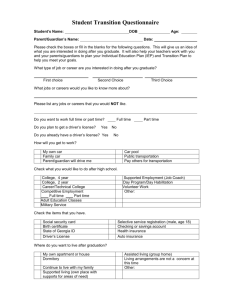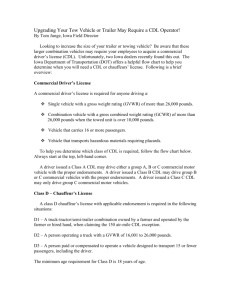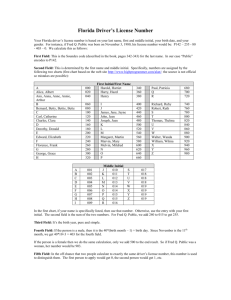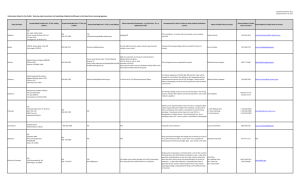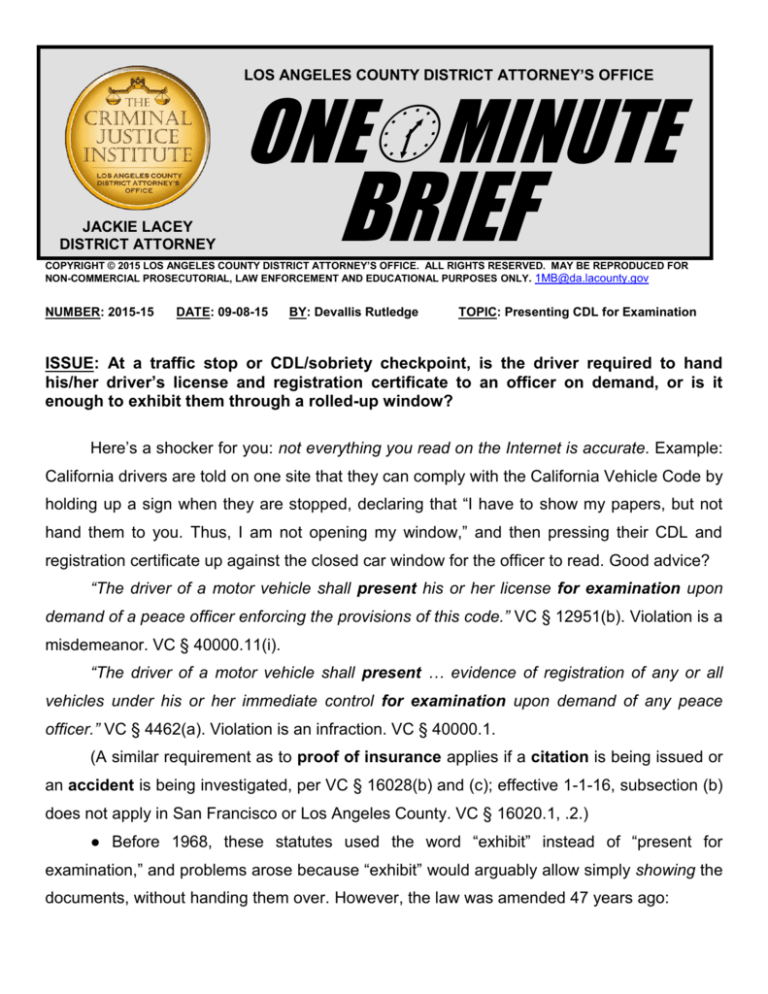
LOS ANGELES COUNTY DISTRICT ATTORNEY’S OFFICE
ONEMINUTE
JACKIE LACEY
DISTRICT ATTORNEY
BRIEF
COPYRIGHT © 2015 LOS ANGELES COUNTY DISTRICT ATTORNEY’S OFFICE. ALL RIGHTS RESERVED. MAY BE REPRODUCED FOR
NON-COMMERCIAL PROSECUTORIAL, LAW ENFORCEMENT AND EDUCATIONAL PURPOSES ONLY. 1MB@da.lacounty.gov
NUMBER: 2015-15
DATE: 09-08-15
BY: Devallis Rutledge
TOPIC: Presenting CDL for Examination
ISSUE: At a traffic stop or CDL/sobriety checkpoint, is the driver required to hand
his/her driver’s license and registration certificate to an officer on demand, or is it
enough to exhibit them through a rolled-up window?
Here’s a shocker for you: not everything you read on the Internet is accurate. Example:
California drivers are told on one site that they can comply with the California Vehicle Code by
holding up a sign when they are stopped, declaring that “I have to show my papers, but not
hand them to you. Thus, I am not opening my window,” and then pressing their CDL and
registration certificate up against the closed car window for the officer to read. Good advice?
“The driver of a motor vehicle shall present his or her license for examination upon
demand of a peace officer enforcing the provisions of this code.” VC § 12951(b). Violation is a
misdemeanor. VC § 40000.11(i).
“The driver of a motor vehicle shall present … evidence of registration of any or all
vehicles under his or her immediate control for examination upon demand of any peace
officer.” VC § 4462(a). Violation is an infraction. VC § 40000.1.
(A similar requirement as to proof of insurance applies if a citation is being issued or
an accident is being investigated, per VC § 16028(b) and (c); effective 1-1-16, subsection (b)
does not apply in San Francisco or Los Angeles County. VC § 16020.1, .2.)
● Before 1968, these statutes used the word “exhibit” instead of “present for
examination,” and problems arose because “exhibit” would arguably allow simply showing the
documents, without handing them over. However, the law was amended 47 years ago:
LADA ONE-MINUTE BRIEF NO. 2015-15
PAGE 2
“The 1968 amendment was intended to clarify that either the driver’s license or
identification must be given to the officer rather than merely exhibited, which in some
instances has been complied with by showing it through a closed window. The license and
identification must be examined to assure validity and the presence of restrictions. … There
can be little doubt that in both circumstances [license and registration], the driver is expected
to surrender the specified documents to the peace officer for examination….”
People v. McKay (2002) 27 Cal.4th 601, 621-22 (Underlined emphases in quoted text.)
● California driver’s licenses have at least 6 anti-forgery features that must be touched,
viewed at an angle, or examined by backlighting. In order for an officer to “examine” a license
“to assure its validity,” it must be “surrendered to the officer.” This cannot occur without rolling
down the window or opening the door. “[E]very motorist knows that the officer will wish to
speak with him, however briefly…. It may be necessary, for example, for the driver to roll
down his window.” People v. Superior Court (Kiefer) (1970) 3 Cal.3d 807, 822.
● At a traffic stop for an observed mover or equipment violation (but not during initial
checkpoint screening), officers may routinely order the driver and all passengers out of the
vehicle. Pennsylvania v. Mimms (1977) 434 US 106, 111 (driver); Maryland v. Wilson (1997)
519 US 408, 415 (passengers). If the driver gets out of the vehicle without the requested
documents, officers may enter the vehicle (safety permitting) to look for them in places where
they could reasonably be expected to be found, and may seize any evidence in plain view. In
re Arturo D. and People v. Hinger (2002) 27 Cal.4th 60, 79.
● Where a driver’s refusal to surrender demanded documents or to roll down the
window or obey an order to get out at a lawful traffic stop constitutes resistance, delay or
obstruction of the lawful performance of official duties, the person may be subject to arrest.
PC § 148(a); cf. People v. Evans (2011) 200 Cal.App.4th 735, 743.
BOTTOM LINE: Upon demand of a peace officer at a lawful traffic stop or CDL/sobriety
checkpoint, the driver must give required documents to the officer, and may not merely
exhibit them through rolled-up glass.
(Emphases added and citations and punctuation omitted in quoted material.)
This information was current as of publication date. It is not intended as legal advice. It is
recommended that readers check for subsequent developments, and consult legal advisors to ensure
currency after publication. Local policies and procedures regarding application should be observed.

